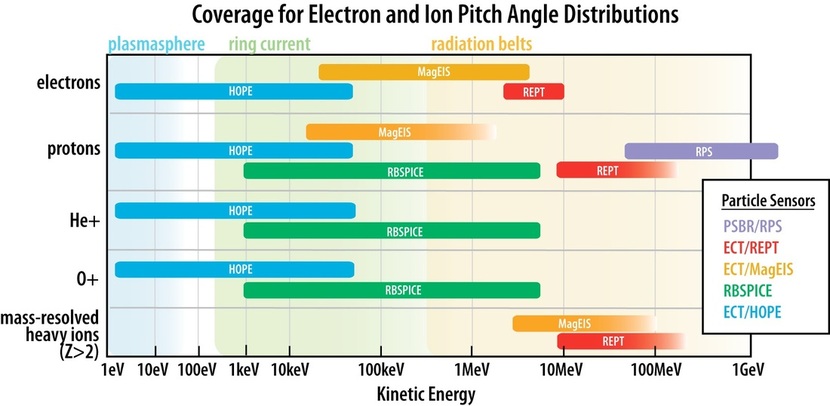RBSP – Instrument Overview
Each RBSP Spacecraft carries an identical Suite of Instruments:
- Energetic Particle, Composition, and Thermal Plasma Suite (ECT)
- Electric and Magnetic Field Instrument Suite and Integrated Science (EMFISIS)
- Electric Field and Waves Suite (EFW)
- Radiation Belt Storm Probes Ion Composition Experiment (RBSPICE)
- Relativistic Proton Spectrometer (RPS)
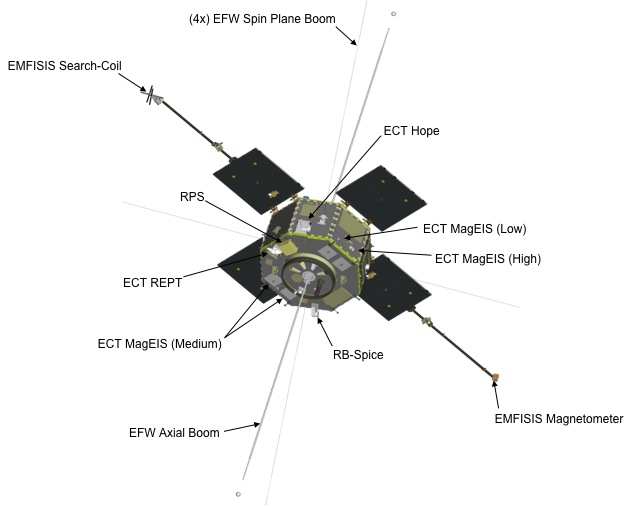
ECT – Energetic Particle, Composition and Plasma Suite
ECT directly observes energetic particles in near-Earth Space to understand the physical processes that control the acceleration, global distribution and variability of particles in the radiation belts. Electrons, protons, and charged ions of oxygen and helium participate in the dynamic changes seen in the belts and are being examined by ECT. The instruments record various information on these particles such as their energy and direction of motion relative to the magnetic field (known as pitch angle) as well as factors that can determine whether a given particle stays trapped in the radiation belts or has sufficient energy to escape. ECT is comprised of three major components. HOPE, MagEIS and REPT. All three instruments are highly coordinated and cover full ion and electron spectra from 1eV to >10MeV.
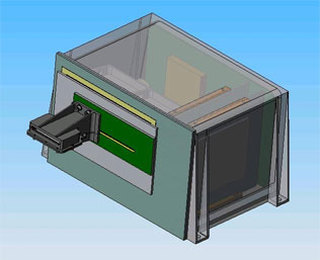
Helium Oxygen Proton Electron – HOPE
HOPE records helium, oxygen, protons, and electrons at lower energies and speeds. It uses an electronic top-hat analyzer and time-gate coincidence detectors to measure these particles with energies of <20kEV to >45keV. Background noise is rejected.
Particles that are being measured by HOPE exist throughout the solar system and play a significant role in Van Allen Belt Dynamics because these slower particles generate electromagnetic waves which can affect higher energy particles trapped in the belts.
.
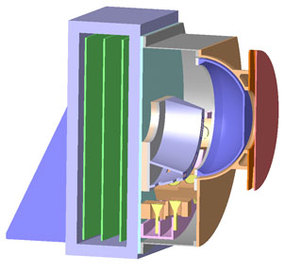
Magnetic Electron Ion Spectrometer (MagEIS)
MagEIS looks at electrons and ions in the middle energy ranges. The instrument uses magnetic focusing and pulse height analysis to measure particles from 30keV to 4MeV for electrons and 20keV to 1MeV for ions.
Magnetic focusing is accomplished by magnets being used to deflect particles towards the senors to distinguish them from background radiation. MagEIS will provide the cleanest measurements of radiation belt electrons to date. A total of four MagEIS Instruments are carried aboard each spacecraft, each covering a particular part of the energy spectrum and a large range of pitch angles.
Relativistic Electron Proton Telescope (REPT)
The highest energy particles will be covered by REPT. Particles from 20 to 75MeV will be examined by the instrument. These relativistic particles will be recorded by solid-state detectors that can capture the energy signatures left by them. The detectors will categorize and count the events.
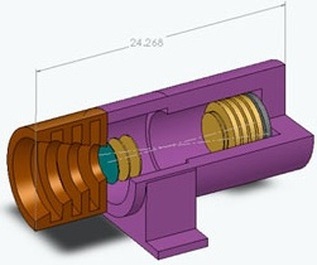
ECT has the following objectives:
- Determine the physical processes that produce radiation belt enhancements
- Determine the dominant mechanisms for relativistic electron loss
- Determine how the inner magnetospheric plasma environment controls radiation belt acceleration and loss
- Develop empirical and physical models for understanding and predicting radiation belt space weather effects
EMFISIS – Electric and Magnetic Field Instrument Suite and Integrated Science
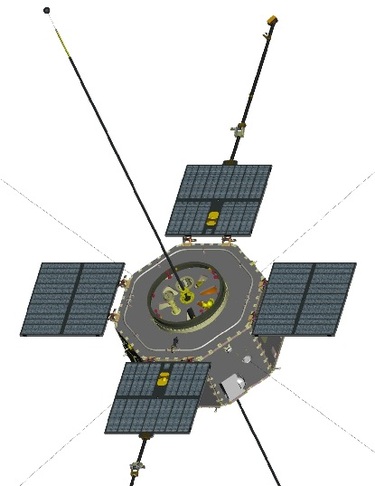
The EMFISIS instrument of RBSP will examine the role played by magnetic fields and plasma waves in the processes of Radiation Belt Acceleration and Loss. It differentiates which processes help provide energy and speed to the particles in the belt or lead to their being ejected from the belts. EMFISIS provides a variety of wave, electric and magnetic field measurements covering frequencies from 10Hz to 400kHz. The instrument suite consists of two sensors: a tri-axial fluxgate magnetometer (MAG) and a tri-axial AC magnetic search coil magnetometer (MSC). To measure AC signals, the Waves experiment includes AC electric fields (from the EFW) experiment and a tri-axial search coil magnetometer. The instrument hardware includes seven printed circuit boards which are used for power supply and data management as well as instrument control.
EMFISIS features a Central Data Processing Unit that provides instrument control and the interface of the instrument with the spacecraft bus. The CDPU also provides on-board analysis capabilities as well as 50Mbytes of Mass Memory.
Magnetometer
The EMFISIS Magnetometer instrument was developed at Goddard Space Flight Center. The Magnetometer design consists of various off-the-shelf components which have and are being flown on different NASA missions and are featuring a successful track record in planetary space flight. The EMFISIS Magnetometer is a wide-range, high performance triaxial fluxgate magnetometer system. Its signal processing, analog to digital converter (A/D) and interface electronics are implemented in a single electronics card that is protected by the Main Electronics Box of the RBSP Spacecraft. The Magnetometer’s Flux Gate and Search Coil Booms are attached to two opposing solar arrays of the spacecraft and extend 3 meter from the edge of the Spacecraft Bus.
Magnetometer Specifications:
Data Rate: ~3 kbs, depending on compression
Sampling Cadence: 64 vectors/s
Ranges: 0 – +/-65536 nT; 0-4096 nT; 0-256 nT
Resolution: 2 nT (65536 nT range); 0.16 nT (4096 nT range); .001 nT (256 nT range)
Accuracy: 0.1 nT (sensor alone, with spacecraft 5 nT)
Frequency Range: 0-30Hz
Waves Instrument and the Magnetic Search Coil (MSC)
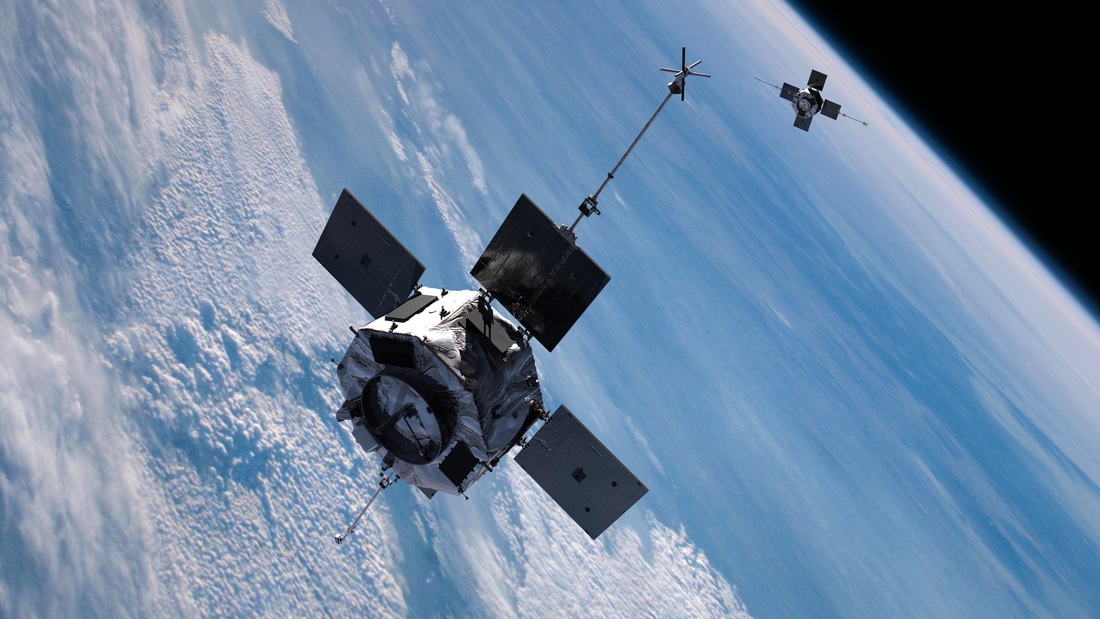
The EMFISIS Waves Instrument looks at plasma waves in the radiation belts to quantitatively determine the effect of these waves on particles present in the Radiation Belts. The instrument measures all three components of the electric field and all three elements of the magnetic field looking at frequencies of 10Hz to 12kHz. It can distinguish between electromagnetic and electrostatic waves. A single electric field component of waves from 10 to 400kHz is also provided by the instrument in order to measure the spectrum of electron cyclotron harmonic emissions and to measure the frequency of the upper hybrid resonance band to deduce electron density. The field signals for the Waves Instrument are provided by the EFW experiment and consists of differential voltages from opposing EFW spherical sensors. Two of these signals are derived from wire booms in the spin-plane of the rotating RBSP Spacecraft. The third signal comes from rigid booms installed along the Spacecraft Axis.
The axial booms of RBSP have a length of 12 meters from tip to tip while the spin plane booms are 40 and 50 meters in length. The Waves magnetic sensor is comprised of three search coil antennas mounted in a tri-axial configuration installed on the boom opposite from the magnetometer boom to reduce any interference.
EMFISIS Objectives:
- Differentiate among competing processes affecting the acceleration and transport of radiation particles
- Differentiate among competing processes affecting the precipitation and loss of radiation belt particles
- Quantify the relative contribution of adiabatic and non-adiabatic processes on energetic particles
- Understand the effects of the ring current and other storm phenomena on radiation electrons and ions
- Understand how and why the ring current and associated phenomena vary during storms
EFW – Electric Field and Waves Suite
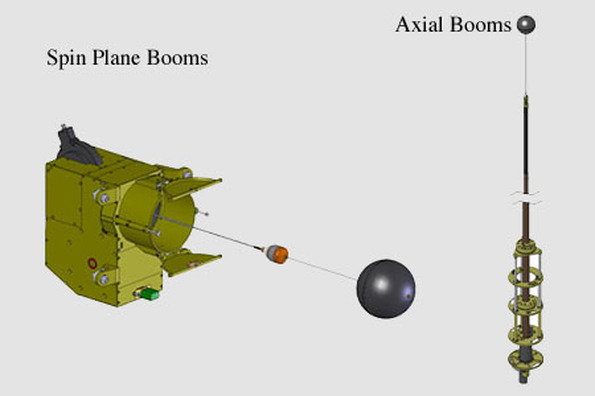
The EFW Sensor Suite measures electric fields to help understand what processes provide energy to particles and speed them on their way. Radiation Belt particles that are energized by electric fields can modify the structure of the inner magnetosphere. The EFW Instrument consists of four Spin-Plane Electric Field Antennae as well as two Axial stacer booms. Metal Spheres and pre-amplifiers are mounted at the ends of those six booms and are used to provide high precision measurements of electric fields. EFW provides information on the electric fields associated with particle energization, scattering and transport, and the role of large-scale convection fields that affect the inner magnetosphere. The Spin Plane Booms are arranged in Pairs with lengths of 40 and 50 meters. The Axial Booms are 12 meters from tip to tip.
EFW Science Objectives:
- Energization by the large-scale convection E-field
- Energization by substorm injection fronts propagating in from the magnetotail
- Radial diffusion of energetic particles mediated by ultra-low frequency (ULF) magnetohydrodynamic (MHD) waves
- Transport and energization by intense magnetosonic waves generated by interplanetary shock impacts upon the magnetosphere
- Coherent and stochastic acceleration and scattering of particles by small-scale, large-amplitude plasma structures, turbulence and waves (electromagnetic and electrostatic ion cyclotron waves, kinetic Alfven waves, solitary waves, electron phase space holes, zero frequency turbulence).
RBSPICE – Radiation Belt Storm Probes Ion Composition Experiment
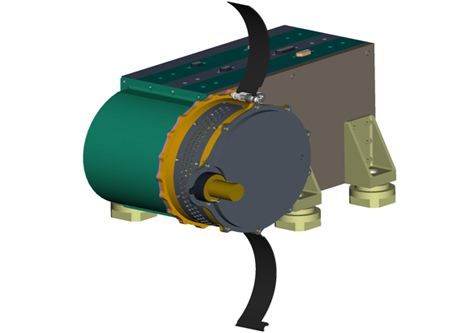
RBSPICE investigates the phenomena of Storm-Time Ring Current around Earth and determines how these effects are created by space weather and how that ring current supplies and supports the creation of radiation populations. The ring current is an electric current circling Earth around its equator. The current changes in response to solar and geomagnetic activity and affects the particles present in the Van Allen Belts. RBSPICE measures the composition (protons, helium and oxygen) and pressure of the ring current. Both of these factors can modify the magnetic fields in Earth’s magnetosphere. Data of the instrument is used to understand how and why the ring current changes during geomagnetic storms and how it affects energetic particles in the Radiation Belts. The instrument suite is a time-of-flight versus energy spectrometer that measures medium energy protons, electrons, and ions (H+, He+, and O+) as functions of energy and angle. Electrons of energy ranges of 25 to 1000keV, Hydrogen particles of 20-10,000keV, Helium ions of 25 to 10,000keV and O+ from 40 to 10,000keV can be measured by the instrument.
RBSPICE is composed of the spectrometer payload called Puck and associated electronics and interfaces that provide power supply and data processing. 414MB of daily raw telemetry are acquired by the instrument that is sent to the RBSPICE Science Operations Center in binary format. This data is being processed to about 750MB of sorted and time tagged event data in ISTP Compliant CDP and CSV format within 14 days of acquisition. Calibrated Flux data is available after 1 month and pitch angle&first moment data products are available after 3 months. L4 Data Level Products are published within 1 year and contain plasma moments, adiabatic invariants and magnetic coordinates. L1 to L4 Science Data will be available to the public.
RBSPICE Science Objectives:
- Understand the effects of the ring current and other storm phenomena on radiation electrons and ions
- Understand how and why the ring current and associated phenomena vary during storms
- Support development and validation of specification models of the radiation belts for solar cycle time scales
RPS – Relativistic Proton Spectrometer
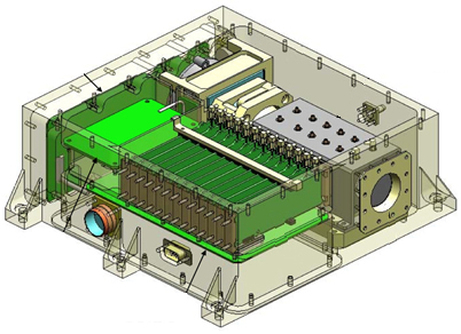
The RPS instrument focuses on the Inner Van Allen Belts that feature the highest energy protons in Earth’s magnetic environment. These particles move fast enough to penetrate inside a spacecraft, where they can harm electronics or astronauts. RPS measures the energy and intensity variation of these protons to help studies looking at changes of the inner belt in response to solar activity.
RPS covers protons with energies of 50MeV to 2GeV. The intensity of trapped protons inside the belts with energies of around 150MeV is not well known and believed to be underestimated in present specification models. These protons present different risks to spacecraft and astronauts including total ionizing dose, displacement damage, single event effects and nuclear activation. All these effects can be harmful to humans. With data acquired by RPS, a new standard radiation model for spacecraft design can be provided.
RPS uses eight stacked Silicon Detectors with incident angle constrained by coincidence detectors for protons of 50 to 400 MeV. A Cherenkov detector is used for protons with higher energies. An instantaneous angular resolution of 30 degrees can be achieved.
RPS Science Objectives:
- Support development of a new AP9/AE9 standard radiation model for spacecraft design
- AFRL to develop and test model for RBSP data in general and RPS specifically
- AP9 (protons) and AE9 (electrons) will provide standardized worst-case specifications: dose rate; internal charging/deep dielectric charging; surface charging (most intense fluxes in keV electrons)
Instrument Coverage
